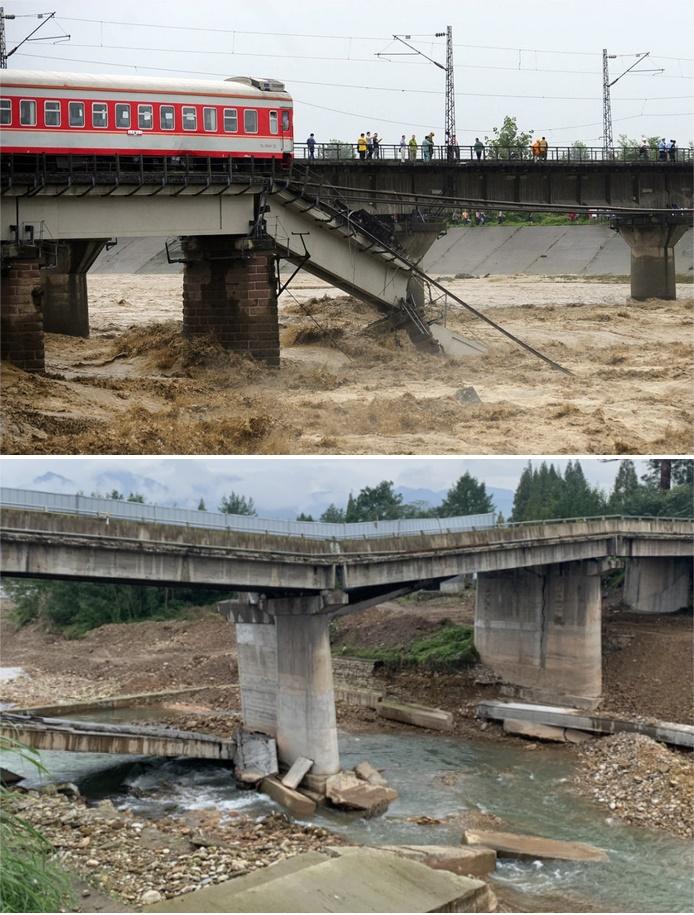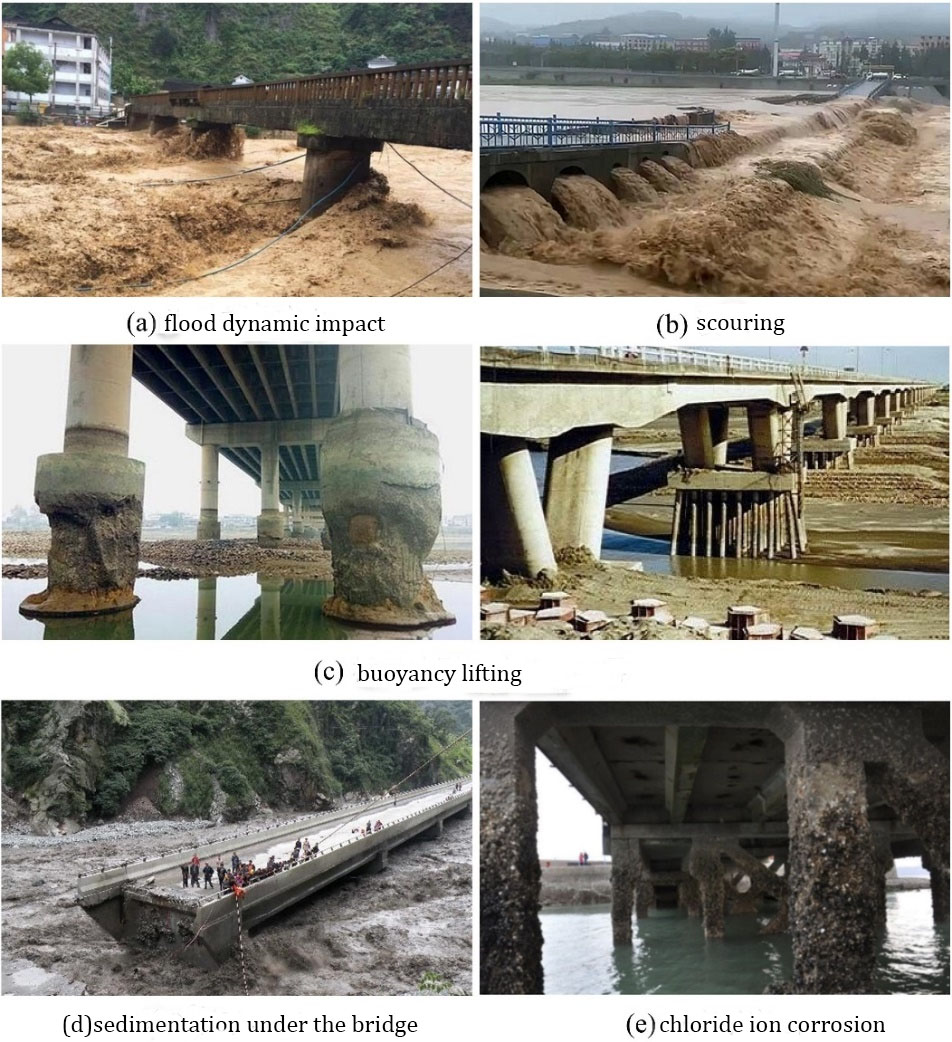Bridge water damage refers to the structural damage or functional failure of a bridge caused by hydrodynamic factors, mainly including phenomena such as scouring, erosion, impact by floating debris, and flood impact. During the annual flood season, bridges are often damaged due to excessive scouring, and the effects of rivers on bridges can also lead to the bridges and their ancillary facilities being unfit for passage, even resulting in road closures and damage, such as flooding, tilting or collapsing due to scouring, and missing railings.
From a statistical and inductive perspective, bridge water damage can be classified into different categories to more systematically analyze its causes and impacts, and thereby formulate effective prevention and control measures. This article will classify bridge water damage from three aspects: the results of water damage, the objects affected by water damage, and the types of actions causing water damage.
According to its impact on the structure and function of the bridge, bridge water damage can be divided into two major categories: bridge collapse and bridge damage.
Bridge collapse refers to the loss of the bearing capacity of the bridge under the action of water damage, and even direct collapse (as shown in Figure 1). This situation usually leads to the complete failure of the bridge, requiring reconstruction or large-scale repairs. Bridge collapse not only has a serious impact on traffic but may also cause casualties and significant economic losses.
Bridge damage can be further divided into structural damage and non-structural damage. Structural damage includes damages that affect the bearing capacity of the bridge, such as pier inclination and abnormal arch axis. This type of damage may lead to the loss of some functions of the bridge, requiring structural reinforcement or partial reconstruction. Non-structural damage includes missing railings, damaged slope protection, and damaged bridge deck, which do not directly affect the bearing capacity of the bridge. This type of damage mainly affects the normal use and aesthetics of the bridge, and the repair is relatively simple.

Figure 1 Floods cause bridge collapse and pier tilt
According to the different objects affected by water damage, bridge water damage can be divided into pier foundation damage, abutment damage, superstructure damage, and main channel deviation of the bridge span, etc. (Figure 2).
The pier foundation is a key component that bears the vertical load of the bridge and the lateral load of the water flow, and the impact of scouring on it is particularly significant. Scouring erodes the riverbed soil around the pier, causing the foundation part to be exposed to the water flow. This can cause surface concrete cracking and internal steel bar corrosion, seriously affecting the bearing capacity of the bridge. In addition, the pier foundation that loses soil support is prone to inclination and deformation, and its bearing capacity and stability will also be significantly reduced. Similar to the pier foundation, the abutment may also lose the necessary support due to the scouring effect, increasing the risk of instability.
For bridges in marine or reservoir areas and flooded bridges, when the water level rises above the bridge deck, the superstructure is easily washed away by the flood. This type of water damage is often manifested as the superstructure of the bridge being washed away or damaged, while the bridge piers remain in place.
The riverbed is unstable, and a major flood may cause the center of the main channel to swing to one side, deviating from the original bridge opening position. At this time, although the bridge structure itself is not damaged, its functions of navigation and flood discharge have been lost.
According to the types of actions causing water damage, bridge water damage can be divided into several forms such as flood dynamic impact, scouring, buoyancy lifting, flooding, abrasion, sedimentation under the bridge, and chloride ion corrosion (as shown in Figure 3). Among them, the dynamic impact of the flood on the bridge is the most intuitive, with the water flow directly exerting a huge force on the bridge laterally, causing brittle failure of the bridge. In extreme flood disasters, the water level in the river channel may rise rapidly and even overflow the bridge deck, and the flood exerts a large horizontal thrust and vertical buoyancy force on the superstructure of the bridge, usually leading to the sliding and shear failure of the bridge bearings and the overall sliding and overturning of the superstructure.
Chloride ion corrosion is a bridge disease caused by seawater, manifested as concrete cracking, peeling, exposed steel bars, and steel bar corrosion. Sea-crossing bridges are exposed to marine air and seawater saturated with salt for a long time. Especially the lower part of the bridge piers and foundations is soaked in deep seawater and is subject to the long-term action of various salts, especially chloride ions. These salts are highly corrosive to engineering materials, directly affecting the quality and durability of the project.

Figure 3 Types of water damage caused by floods
Among various types of water damage classifications, foundation scouring is the most common and has the greatest impact and destructiveness on the bridge structure. Scouring is the process by which the water flow erodes the sediment and other substances around the riverbed, embankment, and bridge foundation. It is affected by hydrological conditions such as water depth, flow direction, and flow velocity, as well as environmental factors such as pier or foundation form, sediment characteristics, and climate change. It is mainly manifested as natural evolution scouring, general scouring, and local scouring. No matter what form of scouring, it will reduce the embedded depth of the bridge foundation, and even cause erosion, exposure, and void at the bottom of the spread foundation, seriously reducing the safety and stability of the bridge structure.
Water damage poses a significant threat to the structural safety and durability of bridges. Therefore, in the process of bridge design, construction, and maintenance, the impact of water damage on the bridge must be fully considered, and corresponding prevention and control measures must be taken. The next article will show you the causes of bridge water damage. Please follow our updates.

International Department: Room 2507-2508, Tower C of Wanda Plaza, Tongzhou District, Beijing 101118, China.
+86-13021287080
info@boyoun.cn